Spiteful Priest Mulligan Strategy & Guide
VS Fast Decks
Higher Priority (Keep every time)
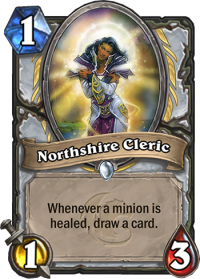
- Northshire Cleric – The only 1-drop in the deck, 1/3 stats means that you can trade into some early 1/1’s or 2/1’s + it might stop your opponent from developing if he will be afraid of you drawing cards.
- Faerie Dragon – Not amazing, but it’s still a 3/2 for 2 + your opponent won’t be able to remove it with spells, which can be quite annoying in some matchups.
- Duskbreaker – Against aggro, this card is the backbone of your deck. Duskbreaker clears most early boards and leaves behind a minion with pretty decent stats. It is often a good plan to keep another Dragon (or Netherspite Historian) in your hand if you’re keeping Duskbreaker, just to ensure that you can play it to clear the board.
- Tar Creeper – With great stats for the cost, Tar Creeper is an excellent early game taunt. This early in the game your opponent might not have a way to silence or otherwise remove it, forcing them to trade their early board into it.
Lower Priority (Keep only if certain conditions are met)
- Shadow Ascendant – With Northshire Cleric. It’s too slow by itself, but if you can follow-up Cleric with it, your chance to win the game goes up by a mile.
- Scaleworm – Rush is great, especially if Aggro deck puts up a Tar Creeper in your way to protect the rest of his board. However, keeping it by itself is too slow – keep it only if you have some of your early drops already.
- Spiteful Summoner – Keeping a 6 mana card might be too slow against Aggro, but it’s still good if you have some of your early game or a board clear already, like Cleric or Duskbreaker. If you don’t, then hard mulligan for those.
VS Slow Decks
Higher Priority (Keep every time)
- Northshire Cleric – Card draw is important. It lets you cycle through your deck faster, meaning that you have a higher chance to drop Spiteful on the curve. It also makes things slightly awkward for your opponent – you might force him to use a removal on a 1/3 in the mid game, where he would prefer to develop something instead.
- Shadow Ascendant – Since there is a lower chance that your opponent will have some board on Turn 1/2, this minion might survive – and if it survives, it snowballs the rest of your board like crazy.
- Curious Glimmerroot – Good Turn 3 play, can put some pressure on your opponent + you don’t lose a card advantage if you pick the right card.
- Spiteful Summoner – Against slower opponents you can be fairly confident you’ll survive until turn 6, and on turn 6 you really want to be playing Spiteful Summoner. The strength of this card comes from making enormous minions several turns earlier than they should be played, and keeping it in your opening hand is the best way to ensure you can play it on curve.
Lower Priority (Keep only if certain conditions are met)
- Twilight Acolyte – Keep in the matchups that might drop a huge minion early – mostly against Cube Warlock, where this card is the Giants’ destroyer.
- Spellbreaker – Keep in the matchups in which Silence is important, e.g. once against against Cube Warlock, where silencing Possessed Lackey can win you the game.
- Twilight Drake – Twilight Drake is mostly played in this deck for lack of a better option, but it does have its upsides. Four attack is difficult for most Priest decks to remove, so against other Priest decks, Twilight Drake is often your strongest minion.
Spiteful Priest Win Rates
Winrate stats are currently unavailable for this deck at the moment!
Spiteful Priest Play Strategy
Vs Aggro
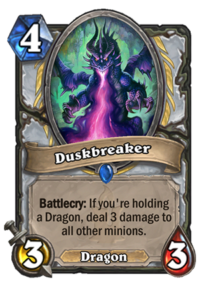
Games vs Aggro tend to be very quick and explosive. Since you run literally no board clears outside of the Duskbreaker, falling behind usually means losing the game (unless you draw your Duskbreaker, of course). You try to stay on the curve and keep trading your opponent’s board. Try to do as many efficient trades as possible – it’s unlikely that you will win the board in the early game, but you can at least reduce the pressure.
Try to use minions over Hero Power as much as possible – play for the tempo. A common misplay when playing this deck is healing a Northshire Cleric on Turn 2 to draw a card instead of dropping a 2-drop, especially Shadow Ascendant. That card is pointless if you will fall behind on the board and lose early. Playing a 2-drop, then 3-drop etc. means that you might be able to keep up with them and your minions are much more efficient when you’re the one dictating trades.
Since you only run 2x Duskbreaker, you need to be a little bit greedy with them. Try to not drop them vs e.g. a board with two 1-drops, unless you’re at a really low life total and you absolutely need to clear them. Another way to immediately impact the board is Scaleworm, which is also a solid card against Aggro – you can run it into something to clear it immediately, and then it will still live, meaning that it’s usually 2 for 1 – good value and good tempo.
Try to drop Spiteful Summoner as soon as possible. The main strength of this card in slow matchups is that it gives you two relatively big bodies to trade with – even if you low roll some mediocre 8-drop it still means that you can clear two minions per turn, which is important if you want to stabilize.
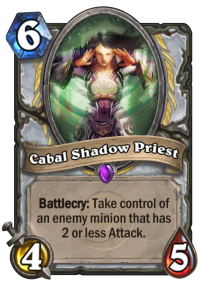
Cabal Shadow Priest tends to be good in the Aggro matchups, at least those who aren’t all-in face decks like Odd Face Hunter. You can steal most of their 1-drops and 2-drops, some of which even have Taunt. E.g. stealing a Righteous Protector vs Odd Paladin or Vulgar Homunculus against Zoo Warlock. But don’t really be picky about it – even stealing a 1/1 on the curve is better than keeping it if you have no other good plays anyway. Every card that can clear a small minion right away is good.
Surprisingly enough, Grand Archivist is also an amazing card against Aggro if you survive that long. The card starts out slowly, but gives you up to 4 turns of powerful plays – even Mind Controlling a small minion is great if you don’t have to actually pay mana for that.
While not exactly Aggro, if you face another Spiteful deck, keep Twilight Acolyte for the minion they summon from Spiteful. Otherwise, if they summon a 12/12 or something, you have literally no way to deal with it (at least until Grand Archivist turn).
Vs Control
When facing Control decks, your game plan switches to all-in offense in most of the matches. There is no reason to play defensive, as a slow deck won’t put pressure on your anyway. You want to start putting pressure ever since the first turns, but not by completely dropping the value. For example, drawing cards from Cleric is still great. One of the best way for Control deck to win against you is run you out of resources, so try to save some of them.
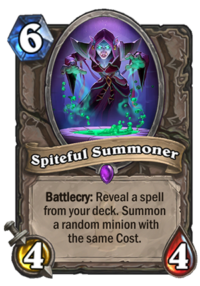
Generally, in the early game you can go all-in on the board. One of the ways to win with this deck is actually through the early game aggression, something opponents rarely mulligan for when facing Priest. Shadow Ascendant is the early game MVP – if they have no way to clear it, it can snowball the game in your favor. Try to deal as much face damage as possible, and overextending a bit onto the board is not bad if you have the mid game refill.
As much as your early game are still quite easy to take down by AoEs and removals, your Turn 4+ plays might not be. Twilight Drake (or Scaleworm if you have something to clear), Cobalt Scalebane and Spiteful Summoner is like a dream curve. Remember that you’re playing the beatdown role, so leave trading for your opponent, as long as you can get away with it. Trading up is okay to protect your bigger minions, but do not trade that 5/5 into let’s say some 2/3. Every point of damage is important.
In the mid game, try to not overextend, because that’s when the big AoE removals come into action. You always want to have some sort of board refill. So if you have one Spiteful Summoner and a big guy on the board already, don’t play another one into e.g. Twisting Nether. Instead, play for example a Curious Glimmerroot – you will still have an extra 3/3 body on the board, but getting AoE’d won’t hurt that much, because you’ve got a card from it already anyway. 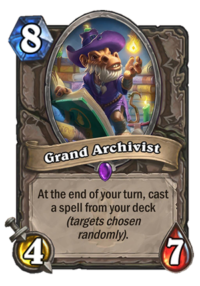
One thing to keep in mind is that Grand Archivist will never cast a spell that doesn’t have a target. So if you play it on an empty board, it will always cast a Free From Amber – you don’t have to worry about burning Mind Control for no reason. At the same time, the minion is most effective when your opponent has a single, bigger minion on the board (e.g. Control Warlock with Voidlord). Him casting Mind Control to steal it is a massive swing, which often leads to a quick victory.
Twilight Acolyte works very well if you need to neutralize a big threat, such as an early Mountain Giant from the Warlock. But there’s nothing wrong about using it on e.g. 3 or 4 Attack minion to just keep the pressure and prevent that minion from killing one of your own. Later into the game, you can combo Twilight Acolyte with Cabal Shadow Priest to steal any minion from your opponent. It’s like a higher tempo Mind Control, but costs 2 cards. It’s AMAZING way to deal with your opponent’s late game minions. They will often try to drop it on Turn 9, before you can Mind Control it, and you can punish them this way. Voidlord is one of the best minions to steal with that combo – not only you get a great Taunt with Deathrattle + more minions on the board, but you remove it from your opponent’s Bloodreaver Gul'dan‘s pool of Demons.
Spiteful Priest Card Substitutions
The deck is actually pretty cheap – this specific version doesn’t run any Legendaries, but it does run quite a lot of Epics. Most of them are necessary and irreplaceable, but some of them can be substituted by something else. Check out the whole list below.
- Curious Glimmerroot – 3/3 for 3 that gives you an extra card is pretty solid. It’s an okay play both in terms of tempo and in terms of value. But if you don’t have it, replacing it isn’t terribly hard. You can play Nightmare Amalgam instead, and if you don’t have it either, you can try out an Acidic Swamp Ooze + either Squashling or Stonehill Defender. You can actually replace one with Acidic Swamp Ooze even if you don’t need a budget replacement – it’s a solid tech card to have.
- Twilight Acolyte – It’s the only card that somehow resembles a big removal you can use before Turn 10 (Mind Control) – without it, cards like Edwin VanCleef or Mountain Giant might beat you really hard. However, if you don’t have it, try the replacements listed above.
- Cabal Shadow Priest – Not necessary, it’s just solid in the current meta + it has a great late game combo with Twilight Acolyte vs slow decks in the slow matchups. If you don’t have it, you can run Wyrmguard instead.
- Spiteful Summoner – It’s the reason why you build a deck this way in the first place, you can’t replace it with any card.
- Grand Archivist – One copy is also absolutely necessary. It lets you cast all of those expensive spells for free, as soon as Turn 8. Provides game-winning swings in lots of matchups.
















Please update this guide for Spiteful Summoner nerf!
I did these changes based off a deck I saw around here somewhere (I’m sorry, I have no clue where the deck is right now, but somewhere in the spiteful priest decks for sure!)
+ 1 Prince Keleseth
+ 1 Lady in White
+ 1 Ysera
+ 2 Nightscale Matriarch
+ 1 Corrosive Sludge
+ 2 Witchwood Grizzly
+ 2 Primordial Drake
+ 2 Wyrmguard
– 2 Shadow Ascendant
– 2 Curious Glimmerroot
– 2 Twilight Acolyte
– 2 Cabal Shadow priest
– 2 Tar Creeper
– 2 Faerie Dragon
The idea was to enable Lady in White’s effect to function as a secondary win condition, I think. Keleseth + Lady make for great synergy, 9/9 Nightscale Matriarchs or 10/10 with Keleseth buff on a 7-drop is nasty as hell. I’ve also been personally experimenting a lot and I plan on removing Twilight Drake and adding Tar Creeper again for the smae reasons. Twilight drake is very counter-synergistic to Lady in White (defaults to 1/1 in stats because of how its HP and battlecry work, meanwhile Tar Creeper gets to 8/5 on enemy turn with Lady buff and 9/6 with Keleseth and Lady. Ysera is there because the deck is slow-paced and control-oriented and she’s obviously a great value generator. Becomes 12/12 with Lady in White buff.
I think this is a great change to the deck since it stops relying solely on drawing Spiteful for the win condition and allows you some other way of winning, since Spiteful is not as reliable anymore, the mana nerf hurts! Keleseth is obviously a staple in spiteful decks and WR skyrockets if he’s in your starting hand. I found this new spin interesting and fun! Even though I rank low because I’m a relatively casual player/collector, I think if I commit I can climb with this deck. What are your thought on it, Stonekeep?
Has this modified version of the deck been working out for you?
It was when the nerfs first hit live, but I imagine that a lot of experimental decks do well. Later on I found I was losing way more than I was winning. The deck just can’t keep up with aggression, even when the opponent’s deck isn’t full aggro. I eventually ditched it, but it was super fun and I love using niche/fringe legendaries like Lady in White. Felt great to win and didn’t feel so bad when I lost, but it was just absurdly slow.
I switched to Quest Priest, which I’ve been doing much better with.
I run yet another variant of this deck and it is working perfectly with a 65% winrate across 200+ games.
Here:
### Spiteful Priest
# Class: Priest
# Format: Standard
# Year of the Raven
#
# 2x (1) Northshire Cleric
# 1x (2) Acidic Swamp Ooze
# 2x (2) Faerie Dragon
# 2x (2) Shadow Ascendant
# 1x (3) Stonehill Defender
# 2x (3) Tar Creeper
# 2x (4) Duskbreaker
# 1x (4) Scaleworm
# 1x (4) Spellbreaker
# 1x (4) Tortollan Shellraiser
# 2x (5) Cobalt Scalebane
# 1x (6) Bone Drake
# 1x (6) Cabal Shadow Priest
# 1x (6) Lady in White
# 2x (7) Nightscale Matriarch
# 2x (7) Spiteful Summoner
# 1x (7) Wyrmguard
# 1x (8) Free From Amber
# 1x (9) Sleepy Dragon
# 1x (9) Ysera
# 2x (10) Mind Control
#
AAECAa0GDJAC8gWKB6IJ3MECm8ICmcgCx8sC5tMCjO8CifECsPsCCQjhBPIMysMCyssCzswCy+YC1+sCju4CAA==
I’ve been running a Keleseth and Lady in White version that’s been working very well. It still has great dragon synergy and it seems you almost always get at least one win-more card (Keleseth, LiW, Spiteful, Archivist) in time to play it on curve.
Could you link the version you’re using? i’m looking for a good liw list
This deck is only for RNG!